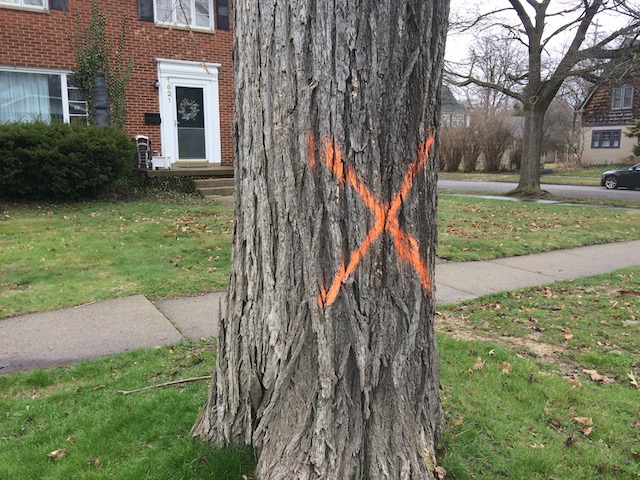By Jan Worth-Nelson
What the project engineer is calling “full reconstruction” of Court Street from Dort Highway to Crapo Street in Flint is scheduled to begin Wednesday, April 22. Work on the estimated $7 million project is expected to last through August, and will entail adjustments for motorists on one of the city’s busiest east-west routes.
Workers will be installing an updated water main and resurfacing Court Street. Eventually sidewalks, most curbs and gutter pans will be replaced as well. The culvert bridge at Gilkey Creek is scheduled to have the sidewalks replaced on both sides, according to Mark Adas, Flint city engineer.
For the duration of the project, only eastbound Court Street will be open, with westbound motorists detoured from Court to Dort Highway and north onto Lapeer, onward to the I-475 overpass re-connecting with westbound Court downtown. A map from the contractor website shows the pathway:

Adas said the water lines being replaced are cast iron. The city’s FastStart water crisis program replaced any lead or galvanized service lines last year in this area, he said.
Spalding DeDecker, headquartered in Rochester, is managing engineer for the project, representing the city and state, with DePonio Contracting of Shelby Township as contractor. Rowe Engineering, with offices in Flint, provided project design.
The project is Phase One of Court Street rehabilitation. Phase Two, resurfacing the heavily-traveled route from Dort Highway to Center Road, is scheduled for 2021.
Trees along the route to be preserved

A row of red “X”s on the trees of E. Court Street alarmed neighbors (Photo by Jan Worth-Nelson)
One neighborhood concern emerged when red “x”s appeared on 29 trees along the construction route. Originally, according to Mike Keeler, president of the College Cultural Neighborhood Association (CCNA), the trees were set to be removed to make room for the water line.
Keeler said he contacted Flint City Councilwoman Kate Fields (4th Ward) who contacted John Daly, Flint city director of transportation infrastructure, who contacted the contractor. Keeler said Daly emailed him quickly with the message, “No chain saws will run until we get to the bottom of this.”
Among all relevant parties, including Rob Bincsik, the city’s director of public works, negotiations resulted in a re-engineered plan to move the water main closer to the curb, thus saving the trees.
Spalding DeDecker’s website now includes an item in its Court Street project FAQs reading, “The City, contractor, and engineer have spent considerable effort to minimize any damage to the existing trees in the area during the installation of the new water main. We anticipate that there will be minimal impact to the trees in this neighborhood.”
Keeler said he was told there might have to be some trimming to make way for some of the construction equipment.
Most of the trees are Norway maples planted in the 1970s or silver maples going back 80 or more years, Keeler said. There’s also one large elm between Maxine and Blanchard streets.
Science, economics argue for saving the trees
The science, aesthetics and economics of keeping them was clear, he said, adding that he appreciated Daly’s quick responses to a neighborhood which highly values its tree canopy.
“For one thing, a big silver maple eats up a lot more carbon than a sapling,” he said, noting what would have changed if the project team replaced what they removed.
Also, he noted, the cost of cutting down and stumping a tree is between $900 and $1,300, based on estimates by the Genesee County Conservation District.
“Why would you spend that kind of money when you don’t have to — and why didn’t they think of moving the water main in the first place? Why does a neighborhood have to squawk?” Keeler said.
Nonetheless, he said the city’s response was gratifying, and the neighborhood’s concerns were taken seriously.
“Here we are — we’re all under stress and upset about the pandemic, and losing those trees would have been a problem for us. But boy, they [the city and contractor] sure came through on this — we are happy,” Keeler said. “It’s really nice to have an administration that answers our calls and give us credibility.”
Funding through MDOT and WIIN
Funding for the City of Flint project came through the Michigan Department of Transportation. In a reminder of outgrowths of the Flint water crisis, replacement of the water main is being funded through the 2016 federal Water Infrastructure Improvements for the Nation (WIIN) Act.
That act, signed by former President Obama, authorized $170 million for communities facing drinking water emergencies, $100 million of it flowing into Flint specifically for lead removal projects through what was tabbed the Drinking Water State Revolving Fund.
Pandemic protections part of project implementation
Construction was allowed to go on during the pandemic because it is considered “essential work” by the State of Michigan. “The contractors and employees are practicing safe COVID-19 procedures as directed by the State,” the company’s website states.
Brad Abar, Spalding DeDeckers’ project manager, who is himself working as much as possible from home, said the crew on the project will have masks available and will be encouraged to practice social distancing when possible. He said most construction companies have masks on hand already because of Occupational Safety and Health Administration (OSHA) regulations on other construction health concerns such as silica dust.
How to get more information
Abar said normally the company would have gone door to door putting up door hangers explaining the project in the neighborhoods adjoining the work, but didn’t feel comfortable doing so because of the coronavirus situation.
Instead, he said, the company has created 24- x 34-inch signs that will be posted at every intersection in the work area. Residents also can sign up for email construction updates at the contractor’s website here.
EVM Editor Jan Worth-Nelson can be reached at janworth1118@gmail.com.



You must be logged in to post a comment.